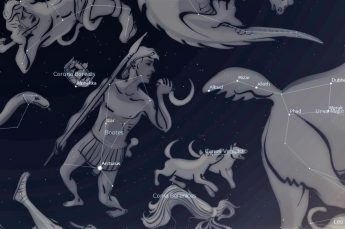This Week’s Sky at a Glance, 2024 Aug 3 – Aug 10
This Week’s Sky at a Glance, 2024 Aug 3 – Aug 10
With the hot and muggy weather this summer there is nothing like an ice cream to cool you down. If the night sky had a constellation honouring the ice cream cone it would have to be the one we call Boötes. Boötes is easy to pick out because it is anchored by Arcturus, the fourth brightest star of the sky. To identify the star, follow the arc of the Big Dipper’s handle to Arcturus. This star is the bottom of the cone and the ice cream is to the left of the Dipper’s handle, somewhat northward where it will stay cold and not melt. The constellation can also pass for a kite or a necktie.
The name Boötes means ox driver but the constellation is often regarded as a bear driver or a ploughman. With his hunting dogs, the Canes Venatici constellation, he is seen chasing the two bears (Ursa Major and Ursa Minor) around the pole. In Britain the Big Dipper is usually called the Plough, and in mythology the goddess of agriculture requested Zeus to honour Boötes in the sky for inventing the plough. I guess he is the John Deere of the night sky, or perhaps Ernest Hamwi who popularized the edible ice cream cone at the 1904 World’s Fair in St. Louis.
Speaking of World’s Fairs, the 1893 and 1933 fairs were held in Chicago. To commemorate technology, the lights for the latter fair were lit using a current generated from photocells and the starlight of Arcturus. It was believed the star was 40 light years distant, so the light reaching them would have been emitted during the previous Chicago fair. We now know Arcturus is only 37 light years away. Several observatories supplied starlight for the opening but, considering the shape of the constellation, it is unfortunate that one of them wasn’t the Lick Observatory in California.
This Week in the Solar System
Saturday’s sunrise is at 6:11 and sunset will occur at 8:48, giving 14 hours, 37 minutes of daylight. Next Saturday the Sun will rise at 6:20 and set at 8:38, giving 14 hours, 18 minutes of daylight.
The Moon is new this Sunday and the slim crescent will be atop Venus with Regulus below on Monday evening. Mercury is to their lower left but probably too dim to be seen with binoculars. Saturn rises around 10:15 pm this weekend. The scenic action in Taurus continues with Mars quickly approaching Jupiter, making an ever-changing triangle with ruddy Aldebaran in the Bull’s eye. By the end of the week we should see an increase in shooting star activity as the Perseid meteor shower begins to ramp up.
The Saint John Astronomy Club meets in the Rockwood Park Interpretation Centre this Saturday at 7 pm. The annual Mount Carleton Star Party takes place next Friday and Saturday, August 9-10, under the darkest sky in the province.

